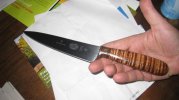You will be as unhappy with a handle coated with a layer of cyanoacrylic as you were with the plain buffed stabilized wood.
If you want a reasonably durable finish ( no finish last forever under kitchen use), what you need to do with the CA is "fill" the wood. You apply CA to the wood surface, wait a while, and sand it all down to the surface. You should see no CA on the actual surface anymore. Repeat this as many times as needed to completely impregnate the surface. You should use good grade sandpaper for the first couple coats, and then switch to 000 steel wool. The wool will start burnishing the surface as it removes the excess CA., If you start too soon with the wool, it may imbed fibers in the pores that can show up as colored spots later. Once it is a smooth and satin surface, with no pores or pits, sand it to as high a grit as practical, 1000 grit is a minimum, finishing with 000 steel wool. A 10X magnifier is useful to tell if all grain and pores are filled fully.
Once the handle is at the finish you like, buff lightly for a nice finish. Hand buffing with lambs wool works well, but if you machine buff with cotton or linen buffs, avoid any heat or pressure. I have used a 6" disc with a lambs wool buff attached as a buffer to get that glass bright finish on a show knife. White compound can help if needed. Try it dry first, you may be surprised how nicely it buffs to a silky sheen.
Touch up will be as simple as a quick buff with 0000 steel wool and a light buff.
Some people build up a surface coat of CA once the wood is filled, often with as may as 20 layers, but I find this impractical for a knife that will get used. CA is an acrylic, and is fairly soft. A surface coating will turn milky or dull quickly with normal use and washing in soapy water.
Almost forgot.....the CA you want is called THIN CA.
Regular CA will not penetrate the wood nearly as well. I have put thin CA on the end grain of a block of wood, and come back to find the wood glued to the workbench. The thin CA wicked all the way through the block to the other end.


